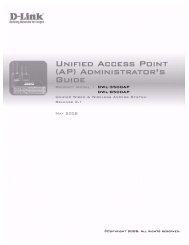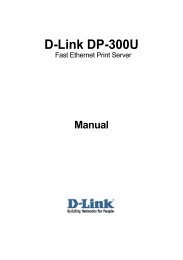Product Manual
Product Manual
Product Manual
Create successful ePaper yourself
Turn your PDF publications into a flip-book with our unique Google optimized e-Paper software.
DES-3526 / DES-3526DC Fast Ethernet Layer 2 Switch<br />
forwarding: The process of sending a packet toward its destination by an internetworking device.<br />
full duplex: A system that allows packets to be transmitted and received at the same time and, in<br />
effect, doubles the potential throughput of a link.<br />
half duplex: A system that allows packets to be transmitted and received, but not at the same time.<br />
Contrast with full duplex.<br />
IP address: Internet Protocol address. A unique identifier for a device attached to a network using<br />
TCP/IP. The address is written as four octets separated with full-stops (periods), and is made up of a<br />
network section, an optional subnet section and a host section.<br />
IPX: Internetwork Packet Exchange. A protocol allowing communication in a NetWare network.<br />
LAN - Local Area Network: A network of connected computing resources (such as PCs, printers,<br />
servers) covering a relatively small geographic area (usually not larger than a floor or building).<br />
Characterized by high data rates and low error rates.<br />
latency: The delay between the time a device receives a packet and the time the packet is forwarded<br />
out of the destination port.<br />
line speed: See baud rate.<br />
main port: The port in a resilient link that carries data traffic in normal operating conditions.<br />
MDI - Medium Dependent Interface: An Ethernet port connection where the transmitter of one<br />
device is connected to the receiver of another device.<br />
MDI-X - Medium Dependent Interface Cross-over: An Ethernet port connection where the internal<br />
transmit and receive lines are crossed.<br />
MIB - Management Information Base: Stores a device's management characteristics and parameters.<br />
MIBs are used by the Simple Network Management Protocol (SNMP) to contain attributes of<br />
their managed systems. The Switch contains its own internal MIB.<br />
multicast: Single packets copied to a specific subset of network addresses. These addresses are<br />
specified in the destination-address field of the packet.<br />
protocol: A set of rules for communication between devices on a network. The rules dictate format,<br />
timing, sequencing and error control.<br />
resilient link: A pair of ports that can be configured so that one will take over data transmission<br />
should the other fail. See also main port and standby port.<br />
RJ-45: Standard 8-wire connectors for IEEE 802.3 10BASE-T networks.<br />
RMON: Remote Monitoring. A subset of SNMP MIB II that allows monitoring and management<br />
capabilities by addressing up to ten different groups of information.<br />
RPS - Redundant Power System: A device that provides a backup source of power when connected<br />
to the Switch.<br />
server farm: A cluster of servers in a centralized location serving a large user population.<br />
SLIP - Serial Line Internet Protocol: A protocol, which allows IP to run over a serial line connection.<br />
SNMP - Simple Network Management Protocol: A protocol originally designed to be used in managing<br />
TCP/IP internets. SNMP is presently implemented on a wide range of computers and networking<br />
equipment and may be used to manage many aspects of network and end station operation.<br />
Spanning Tree Protocol (STP): A bridge-based system for providing fault tolerance on networks.<br />
STP works by allowing you to implement parallel paths for network traffic, and ensure that redundant<br />
paths are disabled when the main paths are operational and enabled if the main paths fail.<br />
stack: A group of network devices that are integrated to form a single logical device.<br />
standby port: The port in a resilient link that will take over data transmission if the main port in the<br />
link fails.<br />
switch: A device, which filters, forwards and floods packets based on the packet's destination address.<br />
The switch learns the addresses associated with each switch port and builds tables based on this<br />
information to be used for the switching decision.<br />
201

















